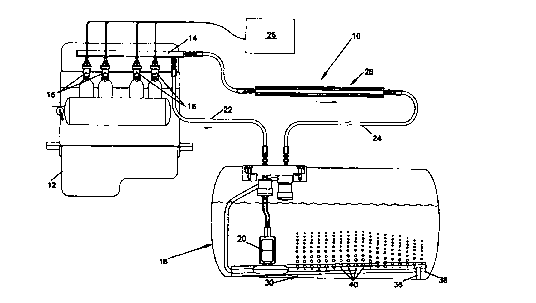Une partie des informations de ce site Web a été fournie par des sources externes. Le gouvernement du Canada n'assume aucune responsabilité concernant la précision, l'actualité ou la fiabilité des informations fournies par les sources externes. Les utilisateurs qui désirent employer cette information devraient consulter directement la source des informations. Le contenu fourni par les sources externes n'est pas assujetti aux exigences sur les langues officielles, la protection des renseignements personnels et l'accessibilité.
L'apparition de différences dans le texte et l'image des Revendications et de l'Abrégé dépend du moment auquel le document est publié. Les textes des Revendications et de l'Abrégé sont affichés :
| (12) Demande de brevet: | (11) CA 2289859 |
|---|---|
| (54) Titre français: | SYSTEME ET PROCEDE D'ALIMENTATION EN GAZ DE PETROLE LIQUEFIE |
| (54) Titre anglais: | LIQUEFIED PETROLEUM GAS FUEL SYSTEM AND METHOD |
| Statut: | Réputée abandonnée et au-delà du délai pour le rétablissement - en attente de la réponse à l’avis de communication rejetée |
| (51) Classification internationale des brevets (CIB): |
|
|---|---|
| (72) Inventeurs : |
|
| (73) Titulaires : |
|
| (71) Demandeurs : |
|
| (74) Agent: | ROBIC AGENCE PI S.E.C./ROBIC IP AGENCY LP |
| (74) Co-agent: | |
| (45) Délivré: | |
| (86) Date de dépôt PCT: | 1998-05-11 |
| (87) Mise à la disponibilité du public: | 1998-11-19 |
| Licence disponible: | S.O. |
| Cédé au domaine public: | S.O. |
| (25) Langue des documents déposés: | Anglais |
| Traité de coopération en matière de brevets (PCT): | Oui |
|---|---|
| (86) Numéro de la demande PCT: | PCT/US1998/009533 |
| (87) Numéro de publication internationale PCT: | WO 1998051923 |
| (85) Entrée nationale: | 1999-11-12 |
| (30) Données de priorité de la demande: | ||||||
|---|---|---|---|---|---|---|
|
Système et procédé d'alimentation en carburant permettant d'abaisser la pression à l'intérieur d'un réservoir à carburant. Ce système convient pour une alimentation en gaz de pétrole liquéfié, dans lequel le carburant est renvoyé au réservoir. Le carburant de retour est refroidi par des dispositifs de transfert thermique disposés dans la conduite de retour, dans la conduite d'alimentation et dans le réservoir.
A fuel supply system and method for reducing the pressure in the fuel tank for
a liquefied petroleum gas fuel supply system in which fuel is returned to the
tank. Return fuel is cooled by heat transfer devices in the return line in
line and in the tank.
Note : Les revendications sont présentées dans la langue officielle dans laquelle elles ont été soumises.
Note : Les descriptions sont présentées dans la langue officielle dans laquelle elles ont été soumises.

2024-08-01 : Dans le cadre de la transition vers les Brevets de nouvelle génération (BNG), la base de données sur les brevets canadiens (BDBC) contient désormais un Historique d'événement plus détaillé, qui reproduit le Journal des événements de notre nouvelle solution interne.
Veuillez noter que les événements débutant par « Inactive : » se réfèrent à des événements qui ne sont plus utilisés dans notre nouvelle solution interne.
Pour une meilleure compréhension de l'état de la demande ou brevet qui figure sur cette page, la rubrique Mise en garde , et les descriptions de Brevet , Historique d'événement , Taxes périodiques et Historique des paiements devraient être consultées.
| Description | Date |
|---|---|
| Inactive : CIB de MCD | 2006-03-12 |
| Inactive : CIB de MCD | 2006-03-12 |
| Inactive : CIB de MCD | 2006-03-12 |
| Demande non rétablie avant l'échéance | 2004-05-11 |
| Inactive : Morte - RE jamais faite | 2004-05-11 |
| Réputée abandonnée - omission de répondre à un avis sur les taxes pour le maintien en état | 2004-05-11 |
| Inactive : Abandon.-RE+surtaxe impayées-Corr envoyée | 2003-05-12 |
| Lettre envoyée | 2000-11-23 |
| Exigences de rétablissement - réputé conforme pour tous les motifs d'abandon | 2000-11-10 |
| Réputée abandonnée - omission de répondre à un avis sur les taxes pour le maintien en état | 2000-05-11 |
| Lettre envoyée | 2000-05-05 |
| Inactive : Transfert individuel | 2000-03-28 |
| Inactive : Page couverture publiée | 2000-01-12 |
| Inactive : CIB attribuée | 2000-01-10 |
| Inactive : CIB en 1re position | 2000-01-10 |
| Inactive : Lettre de courtoisie - Preuve | 1999-12-21 |
| Inactive : Notice - Entrée phase nat. - Pas de RE | 1999-12-14 |
| Demande reçue - PCT | 1999-12-13 |
| Demande publiée (accessible au public) | 1998-11-19 |
| Date d'abandonnement | Raison | Date de rétablissement |
|---|---|---|
| 2004-05-11 | ||
| 2000-05-11 |
Le dernier paiement a été reçu le 2003-04-03
Avis : Si le paiement en totalité n'a pas été reçu au plus tard à la date indiquée, une taxe supplémentaire peut être imposée, soit une des taxes suivantes :
Veuillez vous référer à la page web des taxes sur les brevets de l'OPIC pour voir tous les montants actuels des taxes.
| Type de taxes | Anniversaire | Échéance | Date payée |
|---|---|---|---|
| Taxe nationale de base - générale | 1999-11-12 | ||
| Enregistrement d'un document | 2000-03-28 | ||
| TM (demande, 2e anniv.) - générale | 02 | 2000-05-11 | 2000-11-10 |
| Rétablissement | 2000-11-10 | ||
| TM (demande, 3e anniv.) - générale | 03 | 2001-05-11 | 2001-04-04 |
| TM (demande, 4e anniv.) - générale | 04 | 2002-05-13 | 2002-04-02 |
| TM (demande, 5e anniv.) - générale | 05 | 2003-05-12 | 2003-04-03 |
Les titulaires actuels et antérieures au dossier sont affichés en ordre alphabétique.
| Titulaires actuels au dossier |
|---|
| BENNETT TECHNOLOGIES, L.L.C. |
| Titulaires antérieures au dossier |
|---|
| DAVID E. BENNETT |